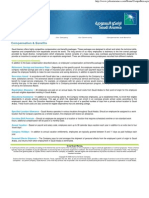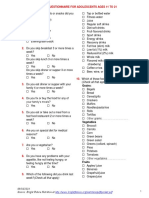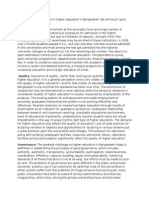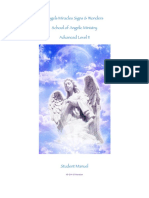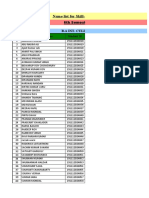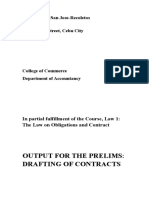Interpersonal Conflict 9th Edition Hocker Solutions Manual
Interpersonal Conflict 9th Edition Hocker Solutions Manual
Uploaded by
hypatiadaisypkmOriginal Description:
Copyright
Available Formats
Share this document
Did you find this document useful?
Is this content inappropriate?
Copyright:
Available Formats
Interpersonal Conflict 9th Edition Hocker Solutions Manual
Interpersonal Conflict 9th Edition Hocker Solutions Manual
Uploaded by
hypatiadaisypkmCopyright:
Available Formats
Interpersonal Conflict 9th Edition
Hocker Solutions Manual
Visit to download the full and correct content document: https://testbankdeal.com/dow
nload/interpersonal-conflict-9th-edition-hocker-solutions-manual/
Chapter 6 Emotions in Conflict
EXAM QUESTIONS:
Chapter 6
TRUE-FALSE
T F 1. Fear and anxiety often influence our choices in managing conflict.
T F 2. The text says “emotions” and “feelings” are the same thing.
T F 3. Conflict worked out in the “middle level” of intensity are managed the
most effectively.
T F 4. Your text recommends showing and sharing all your emotions, no matter how
intense they are, because you will let the other person know how important
the subject is to you.
T F 5. Because anger is such a negative emotion, you should never express it.
T F 6. “Fractionation” is unlikely to work because parties won’t be able to deal
with everything that is bothering them.
T F 7. According to the text, the type of emotions expressed can define the
relationship.
T F 8. Because emotions are not logical, your book recommends that you figure out
your logic before you share your emotions.
T F 9. Experiencing and expressing positive emotions (joy, contentment, etc.) can
lead to empathy and compassion, which ultimately help a person manage conflict.
T F 10. Your authors contend that conflict always occurs on an emotional dimension.
MULTIPLE CHOICE:
1. Emotions are:
a. destructive during conflicts
b. neither “good” or “bad;” they just “are”
c. simple to regulate
d. irrational
e. polite
Ans: B
Hocker: Interpersonal Conflict, 9e TB-6 | 1
© 2014 by McGraw-Hill Education. This is proprietary material solely for authorized instructor use. Not authorized for sale or distribution in any
manner. This document may not be copied, scanned, duplicated, forwarded, distributed, or posted on a website, in whole or part.
Chapter 6 Emotions in Conflict
2. Self-protective emotions are associated with:
a. The right hemisphere of the brain
b. The left hemisphere of the brain
c. Physical triggers
d. Destructive individuals
e. Our identities
Ans: A
3. Prosocial emotions are associated with:
a. The “soft” part of the brain
b. The right hemisphere of the brain
c. The left hemisphere of the brain
d. Competition
e. Negativity
Ans: C
4. Which of the following statements is true?
a. Emotions should not be expressed at work.
b. Emotions hinder good decision making.
c. Emotions should be saved for “later.”
d. Emotions can be managed.
e. Only women are emotional.
Ans: D
5. Lori traditionally hosts Thanksgiving at her house for 10-15 relatives. Rarely do the guests
help with dinner, clean up, or even say “Thank you.” This has been going on for so long that
she resents hosting the dinner. So--This year she assigned each person to bring a food or do
a particular task. A few guests opted out, but the remainder came to dinner, and everyone
(including Lori) had a good time. Lori’s anger served one of many important functions:
a. Seeking revenge
b. Righting a wrong
c. Setting boundaries
d. Giving her a wake-up call
e. Being selfish
Ans: C
Hocker: Interpersonal Conflict, 9e TB-6 | 2
© 2014 by McGraw-Hill Education. This is proprietary material solely for authorized instructor use. Not authorized for sale or distribution in any
manner. This document may not be copied, scanned, duplicated, forwarded, distributed, or posted on a website, in whole or part.
Chapter 6 Emotions in Conflict
6. Which emotion has been termed the “moral” emotion?
a. Anger
b. Sadness
c. Fear
d. Revenge
e. Contempt
Ans: A
7. __________ are more likely than __________ to cover up anger.
a. Men/women
b. Women/men
c. Parents/children
d. Employers/employees
e. Teachers/students
Ans: B
8. __________ are more likely than __________ to cover up sadness.
a. Men/women
b. Women/men
c. Parents/children
d. Employers/employees
e. Teachers/students
Ans: A
9. Too little sadness can result in:
a. Burdens on others
b. Distorted emotional expression
c. Depression
d. Little to no conflict
e. Increased emotional intelligence
Ans: B
Hocker: Interpersonal Conflict, 9e TB-6 | 3
© 2014 by McGraw-Hill Education. This is proprietary material solely for authorized instructor use. Not authorized for sale or distribution in any
manner. This document may not be copied, scanned, duplicated, forwarded, distributed, or posted on a website, in whole or part.
Chapter 6 Emotions in Conflict
10. When we feel extremely intense emotions during conflict, we are usually experiencing a
threat to which of the following elements of the TRIP acronym?
a. Topic
b. Relationship
c. Identity
d. Process
e. None of the above
Ans: C
11. One important part of expressing anger in a responsible manner includes:
a. Verbally stating the anger.
b. Knowing the difference between venting and acknowledging anger.
c. Refusing to attack each other.
d. Uncover the source of your anger.
e. All of these are helpful in responsibly expressing anger.
Ans: E
12. “When you tease me in front of our friends, I feel embarrassed” is an example of:
a. a dysfunctional expression of emotion.
b. venting.
c. attacking your conflict partner.
d. an XYZ statement.
e. a TRIP metaphor.
Ans: D
13. During a year-long divorce and custody dispute, Patrick started calling his soon-to-be ex-
wife terrible names in front of their children and her friends. In response, Becky called
Patrick’s employer and told them what a terrible person Patrick is. Events such as these went
on for months. These behaviors wrecked the couple’s chance for collaboration because each
person was operating on which part of the “intensity continuum”?
a. Unexpressed conflict
b. Moderately expressed conflict
c. Unrestrained conflict
d. Venting
e. Revenge
Ans: C
Hocker: Interpersonal Conflict, 9e TB-6 | 4
© 2014 by McGraw-Hill Education. This is proprietary material solely for authorized instructor use. Not authorized for sale or distribution in any
manner. This document may not be copied, scanned, duplicated, forwarded, distributed, or posted on a website, in whole or part.
Chapter 6 Emotions in Conflict
Short-Answer/Essay
1. Explain the statement that “anger remains or grows rather than lessens with unbounded
expression.”
2. What is the relationship between anger and fear? What about aggression?
3. Explain what it means to be a “Warrior of the Heart.”
4. Describe the “circumplex model of affect,” which includes two dimensions—
pleasant/unpleasant and activation/deactivation. How can this model help you understand
and express your emotions more effectively?
5. What is an XYZ statement? Describe the three parts and write an example for each.
6. Discuss the “tension of opposites”—the urge to either “move toward or against” our
emotions. First, describe the two tensions. Second, provide an example of each. Be sure to
use terms from the text explain this principle of emotion.
7. What do your authors mean when they say you must assume self-responsibility, in terms of
emotions, in order to transform your conflicts with others?
Hocker: Interpersonal Conflict, 9e TB-6 | 5
© 2014 by McGraw-Hill Education. This is proprietary material solely for authorized instructor use. Not authorized for sale or distribution in any
manner. This document may not be copied, scanned, duplicated, forwarded, distributed, or posted on a website, in whole or part.
You might also like
- FBA Keepa GuideDocument50 pagesFBA Keepa GuideMichelle&Wade Farley100% (2)
- American Government and Politics Today The Essentials 17th Edition Bardes Test BankDocument13 pagesAmerican Government and Politics Today The Essentials 17th Edition Bardes Test Bankgloriaelfleda9twuoe100% (40)
- Interpersonal Communication Book The 13th Edition Devito Test BankDocument25 pagesInterpersonal Communication Book The 13th Edition Devito Test BankXavierKimrdon100% (55)
- Internet and World Wide Web How To Program 5th Edition Paul Deitel Test BankDocument25 pagesInternet and World Wide Web How To Program 5th Edition Paul Deitel Test BankGuyBoonexfky100% (63)
- Intimate Personal Violence in Canada Canadian 1st Edition Bake Test BankDocument26 pagesIntimate Personal Violence in Canada Canadian 1st Edition Bake Test BankMichelleBrownfxmk100% (59)
- Aramco Compensation and BenefitsDocument1 pageAramco Compensation and BenefitsJatheesh GeorgeNoch keine Bewertungen
- Nutrition Questionnaire For Adolescents Ages 11 To 21 PDFDocument2 pagesNutrition Questionnaire For Adolescents Ages 11 To 21 PDFEdgar Bronze100% (1)
- Beano's Café Marketing AnswerDocument2 pagesBeano's Café Marketing AnswerJulienne Aristoza100% (4)
- Interpersonal Communication Relating To Others Canadian 7th Edition Beebe Test BankDocument42 pagesInterpersonal Communication Relating To Others Canadian 7th Edition Beebe Test Bankchuseurusmnsn3100% (35)
- Interpersonal Skills in Organizations 5th Edition Janasz Test BankDocument24 pagesInterpersonal Skills in Organizations 5th Edition Janasz Test Bankadelaidelatifahjq8w5100% (34)
- Interpersonal Skills in Organizations 4th Edition Janasz Test BankDocument23 pagesInterpersonal Skills in Organizations 4th Edition Janasz Test Bankadelaidelatifahjq8w5100% (36)
- Interpersonal Communication Book 15th Edition Devito Test BankDocument19 pagesInterpersonal Communication Book 15th Edition Devito Test Bankgwynethalvaf2qroa100% (39)
- Interviewing Principles and Practices 14th Edition Stewart Test BankDocument30 pagesInterviewing Principles and Practices 14th Edition Stewart Test Bankadelaidelatifahjq8w5100% (31)
- International Politics Power and Purpose in Global Affairs 3rd Edition Paul Danieri Test BankDocument14 pagesInternational Politics Power and Purpose in Global Affairs 3rd Edition Paul Danieri Test Bankgwynethalvaf2qroa100% (40)
- International Trade 4th Edition Feenstra Solutions ManualDocument12 pagesInternational Trade 4th Edition Feenstra Solutions Manualscathreddour.ovzp100% (30)
- Human Anatomy 5th Edition Saladin Solutions ManualDocument7 pagesHuman Anatomy 5th Edition Saladin Solutions Manualjillhenrysetcjnzrfp100% (27)
- International Trade 3rd Edition Feenstra Test BankDocument33 pagesInternational Trade 3rd Edition Feenstra Test Bankcuongamandan4c100% (33)
- Operations Management For Mbas 5th Edition Meredith Solutions ManualDocument34 pagesOperations Management For Mbas 5th Edition Meredith Solutions Manualeiranguyenrd8t100% (26)
- American Government and Politics Today Essentials 2015 2016 Edition 18th Edition Bardes Test BankDocument19 pagesAmerican Government and Politics Today Essentials 2015 2016 Edition 18th Edition Bardes Test Bankgloriaelfleda9twuoe100% (41)
- Microeconomics 9th Edition Parkin Test BankDocument38 pagesMicroeconomics 9th Edition Parkin Test Banknbilojanoy100% (20)
- International Trade 4th Edition Feenstra Test BankDocument55 pagesInternational Trade 4th Edition Feenstra Test Bankscathreddour.ovzp100% (28)
- International Politics On The World Stage Brief 8th Edition Rourke Test BankDocument44 pagesInternational Politics On The World Stage Brief 8th Edition Rourke Test Bankcuongamandan4c100% (29)
- Making The Team A Guide For Managers 6th Edition Thompson Solutions ManualDocument13 pagesMaking The Team A Guide For Managers 6th Edition Thompson Solutions Manualletitiahypatiawf76100% (25)
- CCH Federal Taxation Comprehensive Topics 2013 1st Edition Harmelink Solutions ManualDocument17 pagesCCH Federal Taxation Comprehensive Topics 2013 1st Edition Harmelink Solutions Manualbodiandoncella9j9to100% (29)
- Business A Changing World 10th Edition Ferrell Test BankDocument49 pagesBusiness A Changing World 10th Edition Ferrell Test Bankbiancalongf15100% (39)
- International Trade 3rd Edition Feenstra Solutions ManualDocument7 pagesInternational Trade 3rd Edition Feenstra Solutions Manualchuseurusmnsn3100% (36)
- E Commerce Essentials 1st Edition Laudon Test BankDocument18 pagesE Commerce Essentials 1st Edition Laudon Test Bankraphaelbacrqu100% (33)
- Microsoft Access 2013 Comprehensive 1st Edition Pratt Test BankDocument17 pagesMicrosoft Access 2013 Comprehensive 1st Edition Pratt Test Bankgauchofelonyyhjsts100% (38)
- American Government Institutions and Policies 13th Edition Wilson Test BankDocument28 pagesAmerican Government Institutions and Policies 13th Edition Wilson Test Bankadelehuu9y4100% (33)
- Interpersonal Communication Relating To Others Canadian 6th Edition Beebe Test BankDocument26 pagesInterpersonal Communication Relating To Others Canadian 6th Edition Beebe Test BankGuyBoonexfky100% (61)
- International Monetary Financial Economics 1st Edition Daniels Solutions ManualDocument8 pagesInternational Monetary Financial Economics 1st Edition Daniels Solutions Manualhypatiadaisypkm100% (33)
- Introductory and Intermediate Algebra For College Students 4th Edition Blitzer Solutions ManualDocument29 pagesIntroductory and Intermediate Algebra For College Students 4th Edition Blitzer Solutions Manualpentaildeviuoosf100% (32)
- Human Anatomy 8th Edition Martini Solutions ManualDocument26 pagesHuman Anatomy 8th Edition Martini Solutions ManualLeslieBuchanannjfy100% (60)
- Organization Development and Change 10th Edition Cummings Solutions ManualDocument6 pagesOrganization Development and Change 10th Edition Cummings Solutions Manualsyrupselvedgezg8100% (27)
- Canadian Human Resource Management A Strategic Approach Canadian 10th Edition Schwind Test BankDocument40 pagesCanadian Human Resource Management A Strategic Approach Canadian 10th Edition Schwind Test Bankstellafinniandnm1g2100% (35)
- American Government Institutions and Policies 13th Edition Wilson Test BankDocument26 pagesAmerican Government Institutions and Policies 13th Edition Wilson Test BankHeatherBrownjawf100% (59)
- Essentials of Geology 5th Edition Marshak Test BankDocument12 pagesEssentials of Geology 5th Edition Marshak Test Bankxavialaylacs4vl4100% (27)
- Intimate Relationships 8th Edition Degenova Test BankDocument21 pagesIntimate Relationships 8th Edition Degenova Test Bankadelaidelatifahjq8w5100% (36)
- Intimate Relationships 7th Edition Miller Solutions ManualDocument5 pagesIntimate Relationships 7th Edition Miller Solutions Manuallesser.studious27uay100% (30)
- Interpersonal Relationships Professional Communication Skills For Nurses 6th Edition Arnold Test BankDocument26 pagesInterpersonal Relationships Professional Communication Skills For Nurses 6th Edition Arnold Test BankDanielleNelsonxfiq100% (70)
- American Government and Politics Today 2013 2014 Edition 16th Edition Schmidt Solutions ManualDocument15 pagesAmerican Government and Politics Today 2013 2014 Edition 16th Edition Schmidt Solutions Manualmerit.pedant.844mp100% (31)
- Organisational Change Development and Transformation Australia 6th Edition Waddell Solutions ManualDocument25 pagesOrganisational Change Development and Transformation Australia 6th Edition Waddell Solutions ManualChristopherRosefpzt100% (54)
- Microsoft Visual Basic 2017 For Windows Web and Database Applications Comprehensive 1st Edition Hoisington Solutions ManualDocument13 pagesMicrosoft Visual Basic 2017 For Windows Web and Database Applications Comprehensive 1st Edition Hoisington Solutions Manuallilyhubertovkxxb100% (37)
- Economics 19th Edition Mcconnell Solutions ManualDocument8 pagesEconomics 19th Edition Mcconnell Solutions Manualashleyfuentesdvm13051997noj100% (21)
- Marketing Research An Applied Orientation 6th Edition Malhotra Solutions ManualDocument18 pagesMarketing Research An Applied Orientation 6th Edition Malhotra Solutions Manualbiglyerrorfullen2p100% (31)
- International Trade Theory and Policy 11th Edition Krugman Test BankDocument15 pagesInternational Trade Theory and Policy 11th Edition Krugman Test Bankadelaidelatifahjq8w5100% (38)
- Essentials of Marketing Research 3rd Edition Hair Test BankDocument11 pagesEssentials of Marketing Research 3rd Edition Hair Test Bankhanhgloria0hge5100% (32)
- Electrical Control For Machines 7th Edition Lobsiger Test BankDocument3 pagesElectrical Control For Machines 7th Edition Lobsiger Test Bankjohnquyzwo9qa100% (36)
- Fundamentals of Human Resource Management 7th Edition Noe Test BankDocument24 pagesFundamentals of Human Resource Management 7th Edition Noe Test BankDavidLarsonDDSpgkn100% (39)
- Exploring Marketing Research 11th Edition Babin Solutions ManualDocument16 pagesExploring Marketing Research 11th Edition Babin Solutions Manualjudaizerwekaezo8a100% (34)
- Psychology 4th Edition Ciccarelli Solutions ManualDocument38 pagesPsychology 4th Edition Ciccarelli Solutions Manualmrissaancun100% (21)
- Exploring Social Psychology 6th Edition Myers Test BankDocument8 pagesExploring Social Psychology 6th Edition Myers Test Bankcoilwheyb7wsk100% (37)
- International Marketing 3rd Edition Dana Test BankDocument26 pagesInternational Marketing 3rd Edition Dana Test Bankterpinolrepeatereirvm100% (40)
- Managing Business Ethics Straight Talk About How To Do It Right 6th Edition Trevino Solutions ManualDocument11 pagesManaging Business Ethics Straight Talk About How To Do It Right 6th Edition Trevino Solutions Manualing.approof435g100% (28)
- Basic Clinical Lab Competencies For Respiratory Care 5th Edition White Test BankDocument8 pagesBasic Clinical Lab Competencies For Respiratory Care 5th Edition White Test Bankclaraninht5sqdj100% (38)
- Human Exceptionality School Community and Family 11th Edition Hardman Solutions ManualDocument11 pagesHuman Exceptionality School Community and Family 11th Edition Hardman Solutions Manualantheagian4p4y4100% (38)
- Java How To Program 9th Edition Deitel Solutions ManualDocument4 pagesJava How To Program 9th Edition Deitel Solutions Manualmorgaycarter.tizes100% (29)
- Introducing Physical Geography 5th Edition Strahler Test BankDocument34 pagesIntroducing Physical Geography 5th Edition Strahler Test Bankadelaidelatifahjq8w5100% (34)
- Understanding Nutrition Canadian 2nd Edition Whitney Solutions ManualDocument21 pagesUnderstanding Nutrition Canadian 2nd Edition Whitney Solutions Manualimpetigo.outroar5tir100% (27)
- Sports in Society 12th Edition Coakley Test BankDocument19 pagesSports in Society 12th Edition Coakley Test Bankvernier.decyliclnn4100% (27)
- Building A Medical Vocabulary 9th Edition Leonard Test BankDocument25 pagesBuilding A Medical Vocabulary 9th Edition Leonard Test BankChristopherSchmidtxjs100% (51)
- Test Bank For Society The Basics 11th Edition MacionisDocument36 pagesTest Bank For Society The Basics 11th Edition Macionishelixloot5noyc2100% (38)
- Introducing Comparative Politics Concepts and Cases in Context 3rd Edition Orvis Test BankDocument21 pagesIntroducing Comparative Politics Concepts and Cases in Context 3rd Edition Orvis Test Bankkarakulichth.yic5f100% (30)
- Interpersonal Conflict 9Th Edition Hocker Solutions Manual Full Chapter PDFDocument27 pagesInterpersonal Conflict 9Th Edition Hocker Solutions Manual Full Chapter PDFhungden8pne100% (13)
- Instant Download Financial Accounting Fundamentals 5th Edition Wild Test Bank PDF Full ChapterDocument33 pagesInstant Download Financial Accounting Fundamentals 5th Edition Wild Test Bank PDF Full Chapterhypatiadaisypkm100% (13)
- Instant Download Financial Accounting Canadian 6th Edition Libby Solutions Manual PDF Full ChapterDocument32 pagesInstant Download Financial Accounting Canadian 6th Edition Libby Solutions Manual PDF Full Chapterhypatiadaisypkm100% (13)
- Introduction To C Programming and Data Structures 4th Edition Liang Solutions ManualDocument5 pagesIntroduction To C Programming and Data Structures 4th Edition Liang Solutions Manualhypatiadaisypkm100% (24)
- Introduction To Finance Markets Investments and Financial Management 14th Edition Melicher Solutions ManualDocument24 pagesIntroduction To Finance Markets Investments and Financial Management 14th Edition Melicher Solutions ManualhypatiadaisypkmNoch keine Bewertungen
- International Monetary Financial Economics 1st Edition Daniels Solutions ManualDocument8 pagesInternational Monetary Financial Economics 1st Edition Daniels Solutions Manualhypatiadaisypkm100% (33)
- Damen Year Book No4 PDFDocument55 pagesDamen Year Book No4 PDFCarlos Marcelo CostaNoch keine Bewertungen
- Problem in Higher Education in BDDocument4 pagesProblem in Higher Education in BDmaher50% (2)
- Diane Tait Sunday May 19 2024 Rev1 PDFDocument2 pagesDiane Tait Sunday May 19 2024 Rev1 PDFapi-300781429Noch keine Bewertungen
- Officials Eyeing Pension Oddities: He Imes EaderDocument44 pagesOfficials Eyeing Pension Oddities: He Imes EaderThe Times LeaderNoch keine Bewertungen
- Handbook On Cabinet NoteDocument65 pagesHandbook On Cabinet NotePratik JainNoch keine Bewertungen
- PrecedentDocument23 pagesPrecedentBadsha MiaNoch keine Bewertungen
- 2023 TP 1 Private and Personal InformationDocument5 pages2023 TP 1 Private and Personal InformationNieves MateoNoch keine Bewertungen
- Vohra Sadikbhai Rajakbhai and Ors Vs State of GujaSC20161705161628023COM18766Document10 pagesVohra Sadikbhai Rajakbhai and Ors Vs State of GujaSC20161705161628023COM18766UTKARSH GUPTANoch keine Bewertungen
- In The Court of Appeal of The Republic of Singapore: (2020) SGCA 06Document33 pagesIn The Court of Appeal of The Republic of Singapore: (2020) SGCA 06Faizan BhatNoch keine Bewertungen
- Project ProposalDocument9 pagesProject ProposalNavin Nischal MandalNoch keine Bewertungen
- Exercise 3Document2 pagesExercise 3Ju Ing GanNoch keine Bewertungen
- Ao - 1d4chanDocument3 pagesAo - 1d4chanphigibecetmatraNoch keine Bewertungen
- Angels Miracles Signs & Wonders School of Angelic Ministry Advanced Level IIDocument43 pagesAngels Miracles Signs & Wonders School of Angelic Ministry Advanced Level IIEL EL100% (2)
- Ciocto23 ImteyazDocument5 pagesCiocto23 ImteyazazzuNoch keine Bewertungen
- Theories of Knowledge Management: 1. Nonaka and Takeuchi Knowledge Spiral ModelDocument18 pagesTheories of Knowledge Management: 1. Nonaka and Takeuchi Knowledge Spiral ModelKoolet GalNoch keine Bewertungen
- KAFD A2 209 SAB ELE IRE 00129 R00 - ReplyDocument238 pagesKAFD A2 209 SAB ELE IRE 00129 R00 - ReplywagwahkiabatheNoch keine Bewertungen
- Name List For Skill-X & Project and Seminar Presentation ESE JUNE - 2021Document30 pagesName List For Skill-X & Project and Seminar Presentation ESE JUNE - 2021Ayan SamantaNoch keine Bewertungen
- Katsucon RegulationDocument2 pagesKatsucon Regulationtkell234Noch keine Bewertungen
- Paideia Final Paper - Nayunipati - 17-18Document10 pagesPaideia Final Paper - Nayunipati - 17-18api-389379178Noch keine Bewertungen
- Exclusive Distribution AgreementDocument26 pagesExclusive Distribution AgreementMarianne OberesNoch keine Bewertungen
- 38 Parasrampuria Synthetics LTD 20 Sot 248Document5 pages38 Parasrampuria Synthetics LTD 20 Sot 248Chanakya ReddyNoch keine Bewertungen
- Sun Tzu On ManagementDocument13 pagesSun Tzu On Managementyongbm313100% (1)
- Noteson CubismDocument12 pagesNoteson Cubismsobukwe190Noch keine Bewertungen
- In 961HF2 AdministratorGuide enDocument320 pagesIn 961HF2 AdministratorGuide enManisundaramNoch keine Bewertungen
- Macbeth: William ShakespeareDocument12 pagesMacbeth: William ShakespeareAkhlaq HashmiNoch keine Bewertungen
- Midyear Reviewers FinalsDocument35 pagesMidyear Reviewers FinalsDecadeDuosNoch keine Bewertungen





